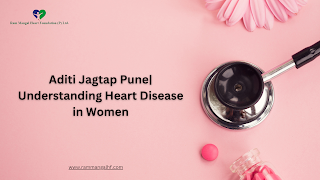Aditi Jagtap Pune | Understanding Heart Disease in Women
For decades, heart disease has been widely perceived as a “man’s illness.” However, reality paints a vastly different picture. Today, heart disease remains the leading cause of death for women in the United States, claiming more lives than all forms of cancer combined. Despite this alarming statistic, many women remain unaware of their vulnerability to this silent threat.
This blog aims to empower women with knowledge about heart disease, its risk factors, symptoms, and preventive measures. By shedding light on this critical issue, we can encourage proactive approaches to protecting our cardiovascular health and build a future where fewer women fall victim to this preventable condition, says Dr. Ranjit Jagtap Daughter.
Beyond the Stereotype: Why Women are at Risk
While both men and women are susceptible to heart disease, biological and hormonal differences put women at unique risk. Some key factors contribute to this vulnerability:
- Hormonal Shifts: Estrogen, a female hormone, offers some protection against heart disease before menopause. However, after menopause, estrogen levels decline, significantly increasing the risk.
- Pregnancy Complications: Certain pregnancy complications like gestational diabetes and preeclampsia can raise a woman’s lifetime risk of heart disease.
- Smaller Heart and Blood Vessels: Women typically have smaller hearts and blood vessels compared to men, making them more susceptible to blockages and reduced blood flow.
- Unique Symptoms: Women may experience heart attack symptoms differently than men, often presenting with nausea, fatigue, or jaw pain instead of the classic chest pain.
Know the Risk Factors:
According to Dr. Ranjit Jagtap daughter, Understanding your individual risk factors empowers you to take preventive measures. These include:
- Family History: Having a close relative with heart disease increases your risk.
- Lifestyle Habits: Unhealthy cholesterol levels, high blood pressure, smoking, and physical inactivity are significant contributors.
- Medical Conditions: Diabetes, obesity, and sleep apnea can heighten your risk.
- Stress: Chronic stress can negatively impact heart health.
Recognizing the Signs:
Early detection is crucial for effective treatment. Be aware of these potential warning signs of heart disease in women:
- Chest discomfort: While chest pain is common, women may also experience tightness, pressure, or squeezing in the chest, neck, jaw, or upper back.
- Pain radiating to the arm: Discomfort radiating down the left arm is common, but pain in the right arm, shoulder, or back should not be ignored.
- Shortness of breath: Difficulty breathing, especially during exertion, can be a warning sign.
- Unusual fatigue: Unexplained and persistent fatigue could indicate underlying heart issues.
- Other symptoms: Dizziness, nausea, lightheadedness, and excessive sweating can be associated with heart problems.
Empowering Yourself through Prevention:
The good news is that heart disease is largely preventable. By adopting healthy lifestyle choices, you can significantly reduce your risk:
- Maintain a healthy weight: Aim for a healthy body mass index (BMI) through a balanced diet and regular exercise.
- Eat a heart-healthy diet: Choose fruits, vegetables, whole grains, lean protein, and limit saturated and trans fats.
- Get regular exercise: Aim for at least 150 minutes of moderate-intensity exercise per week.
- Manage stress: Find healthy ways to manage stress, like yoga, meditation, or spending time in nature.
- Don’t smoke: Quitting smoking is one of the best things you can do for your heart health.
- Schedule regular checkups: Maintain regular appointments with your doctor for monitoring and early detection.
Remember: It’s never too late to start taking charge of your heart health. Talk to your doctor about your individual risk factors and create a personalized prevention plan. According to Aditi Jagtap Pune, By educating yourself, advocating for your health, and making informed choices, you can empower yourself to live a long and healthy life, free from the shadow of heart disease.




Comments
Post a Comment